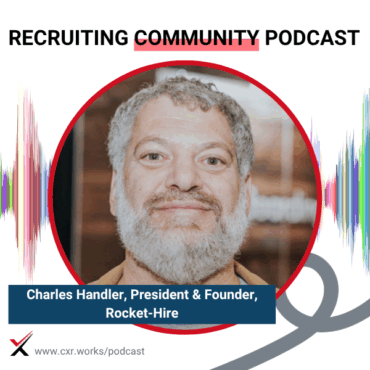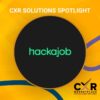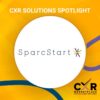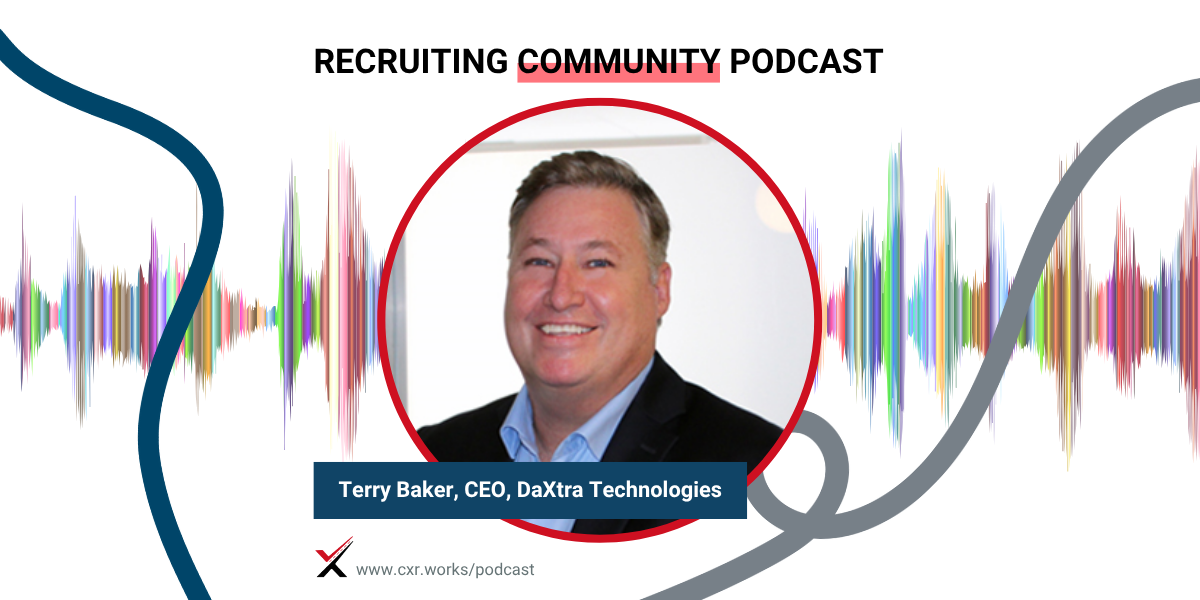
Reframing AI in Hiring
How are AI-powered simulations reshaping hiring? Charles Handler breaks down the shift toward engaging, scalable assessments built on real job behavior.
 play_arrow
play_arrow
Solutions Spotlight on Hackajob Cami Grace
 play_arrow
play_arrow
A Headhunter Changed Everything: Rob Daugherty’s Career Crossroads Cami Grace
 play_arrow
play_arrow
Solutions Spotlight on SparcStart Cami Grace
 play_arrow
play_arrow
From Operations to Coaching: Lori Chartrand’s Career Crossroads Cami Grace

Episode Overview:
Terry Baker, CEO of Dextra Technologies, shares his expert insights on the challenges and opportunities presented by AI in the HR tech space. The conversation also touches on upcoming industry events and offers a light-hearted look at how AI complements human capabilities in recruitment.
Key Topics Covered:
Challenges of AI-Powered Solutions:
Challenges of AI-Powered Solutions: Terry discusses the difficulties faced by HR leaders who have limited experience with AI applications, emphasizing the need for vendors to demonstrate the technology’s ROI and ease of integration.
Data Quality and AI Performance:
The impact of data quality on AI’s effectiveness was a major focus, highlighting how poor data can lead to less effective AI outcomes.
Ethical Considerations and Bias in AI:
The conversation also explored the ethical implications of AI in recruitment, particularly around data privacy and the potential for bias, emphasizing the importance of transparency in AI algorithms.
Closing Notes:
This episode not only sheds light on the technical aspects of AI in recruitment but also humanizes the discussion, making it accessible and engaging for professionals across all levels of expertise. The sessions wraps up with gratitude to Terry Baker for his contributions and tease future engagements that promise to delve deeper into the intersections of AI and human resource management. The emphasis is on the continuous learning and adaptation required to leverage AI effectively in improving recruitment outcomes.
Title:
The Challenge of AI-Powered Solutions
Featured Guests:
Terry Baker, CEO, Daxtra Technologies
Hosts:
Chris Hoyt, President, CareerXroads
Gerry Crispin, Principal & Co-founder, CareerXroads
Episode Overview:
Terry Baker joins the show to discuss the real-world challenges and opportunities of AI adoption in talent acquisition. With decades of experience in HR technology and artificial intelligence, Terry shares insights from his work at Daxtra Technologies, covering AI implementation, data quality, transparency, and the critical partnership between humans and machines.
Key Topics:
HR Tech conference circuit and SHRM survey statistics
The state of AI readiness among HR professionals
Complementary roles of AI and human judgment
Importance of high-quality data for accurate AI outputs
Use of LLMs to build custom taxonomies and scoring systems
Internal mobility and merging of HRIS and ATS workflows
AI transparency and bias mitigation strategies
Conversational AI within ATS platforms
Reimagining recruiter roles in the age of automation
Notable Quotes:
“AI is only as good as the data you feed it. Garbage in, garbage out.” —Terry Baker
“You get transparency. It shows why a candidate scored high.” —Terry Baker
“Talent leaders need to reimagine roles and structures now.” —Gerry Crispin
“We’re hearing our members ask: Do I return headcount, build a COE, hire for new AI skills?” —Chris Hoyt
“AI Meets Human Capabilities. It’s not about replacing people—it’s about empowering them.” —Terry Baker
Takeaways:
AI is transforming talent acquisition, but success hinges on data quality, transparency, and human-AI collaboration. Terry Baker emphasizes that AI tools should empower recruiters, not replace them. As organizations adopt these technologies, they must also reimagine structures, integrate internal mobility workflows, and ensure that AI decisions are fair, explainable, and ethically sound.
Want more conversations like this?
Subscribe to the CXR podcast and explore how top talent leaders are shaping the future of recruiting. Learn more about the CareerXroads community at cxr.works.
Chris Hoyt: All right, gentlemen. I think all of us have some travel coming up. We’re coming out of a holiday weekend, but I feel like this is a busy conference season. Jerry and I have an agenda, but Terry, you’re on the road this fall too, right? You just came back from a SHRM event?
Terry Baker: Just got back from HR Florida. I’ll be at HR Tech and the SIA Collaboration and Gig Economy event in Dallas. Then there’s HR Southwest coming up—another big one.
Chris Hoyt: Is HR Southwest in Fort Worth?
Terry Baker: Yes, Fort Worth.
Chris Hoyt: I’m shocked I knew that. Jerry, we won’t be at HR Southwest, but we’ve got a few events coming up. Where will people see the hat?
Gerry Crispin: Next week, I’ll be in Nashville. It’ll take me about two and a half days to get there—I’m driving the Airstream and parking outside Bicentennial Park. If anyone’s around, we can have a little campfire before everyone heads off to their events.
Chris Hoyt: Will there be s’mores?
Gerry Crispin: I would definitely offer some s’mores.
Chris Hoyt: I might get on a plane just for that. A campfire with Jerry and s’mores? We need a YouTube crew to document that.
Gerry Crispin: It’ll be a cool little event.
Chris Hoyt: Absolutely. All right—let’s get started.
Announcer: CXR Channel—our premier podcast for talent acquisition and talent management. Listen in as the CXR community discusses topics focused on attracting, engaging, and retaining top talent. We’re glad you’re here.
Chris Hoyt: Welcome, everyone! That intro felt like it went on forever. But welcome to the Recruiting Community Podcast. We do weekly insights and updates, bringing in interesting people for what we call easy conversations.
I’m your host, Crazy Legs, and with me is… Ken?
Gerry Crispin: Oh God.
Chris Hoyt: I don’t know how to follow that. We’re the Rock Steady Crew. You remember them, right? Breakdancing legends? No? There’s a lot of breakdancing news lately, I swear.
Anyway, we’re talking with Terry Baker, CEO of Daxtra Technologies. We’re diving into the challenges of AI-powered solutions and data quality.
Quick housekeeping: We’re streaming live on YouTube, Facebook, LinkedIn, and Twitch. You can see past and future episodes at cxr.works/podcast. If you’re watching live on LinkedIn, drop a hello in the chat—we might even throw it up on screen.
This is an ad-free labor of love. Jerry, we’re on episode 320-something—can you believe that?
Gerry Crispin: Feels like episode two sometimes.
Chris Hoyt: Quick plug—Jerry, we recently published a report on conflicts of interest and transparency. Want to give folks the quick overview?
Gerry Crispin: Sure. There’s a ton of investment in HR technology these days—tens or even hundreds of billions of dollars. We believe there should be more transparency around who’s getting paid by whom. We gathered 50–60 folks—vendors, suppliers, practitioners—to talk about how to disclose affiliations when discussing products or speaking at conferences. It’s about enabling people to make informed decisions.
Chris Hoyt: That’s at cxr.org/coi if you want to read or download the report. It’s about 30 pages long and released under Creative Commons.
Now let’s bring in our guest. Terry, how are you?
Terry Baker: Doing great—happy to be here. Took 323 episodes, but I finally made it!
Chris Hoyt: Right? I can’t believe it’s taken this long. You’ve been under our radar. We only have about 11 loyal listeners—so no pressure.
Unannounced segment: Dad jokes! Gentlemen, how’s your dad joke game?
Gerry Crispin: If I had known in advance, I’d have brought one.
Chris Hoyt: Fair. I’ll set the bar. Have you heard about the band 1023MB?
They haven’t gotten a gig yet.
Terry groans
Terry Baker: I’ve raised six kids—you’d think I’d have a few dad jokes.
Chris Hoyt: One more. What’s a pirate’s favorite letter?
You think it’s “R,” but it’s the “C.”
Gerry Crispin: Ahhh, the “C.”
Chris Hoyt: Bad jokes, but fun. We’ll make it a recurring bit. Terry, now that we’ve embarrassed ourselves, why don’t you introduce yourself?
Terry Baker: Sure. I’ve been in HR tech for 25 years. I spent over 20 of those years in AI development. One of the companies I worked with was PandoLogic. We pivoted in 2019 from being a private-label job board to a programmatic platform based on AI.
Now I’m with Daxtra, which has been doing machine learning and linguistic analysis for 23 years. Really strong track record in AI development.
Chris Hoyt: That’s great context. You mentioned a SHRM stat earlier that I think sets the stage well. Can you share that?
Terry Baker: SHRM published a survey just last month showing that 62% of HR leaders report having limited practical experience with AI-powered applications. That’s a problem for vendors like us selling AI tools to TA teams. It puts the responsibility on us to educate and demonstrate the value of our solutions.
Gerry Crispin: And if they don’t know what they don’t know, they don’t even know what questions to ask. That’s why we’ve been developing resources like our AI RFI/RFP toolkit to help employers have more informed conversations.
Terry Baker: One more stat from SHRM—88% of HR leaders believe AI should complement human capabilities. That’s encouraging. It means they’re not afraid—it’s about partnership between tech and people.
Chris Hoyt: I’ve noticed that shift too. The conversation has moved from “AI will take our jobs” to “How can AI make us better at what we do?”
Terry Baker: Exactly. According to SIA, the top three areas of AI disruption are: candidate screening and skills assessment, matching and selection, and internal mobility or redeployment.
With good data, AI can do an excellent job scoring and ranking candidates, but recruiters still need to evaluate soft skills and cultural fit. AI should serve up insights—not replace humans.
Chris Hoyt: Let’s talk about data quality. Why is it so critical for AI to work well?
Terry Baker: AI is only as good as the data you feed it. Garbage in, garbage out.
Parsing resumes and job descriptions accurately is essential. We’ve sold to some of the biggest companies—Google, Amazon, Apple, Meta—and they all do trials before adopting. Our parsing is top-tier because we’ve spent decades refining it.
We even built a taxonomy for solar engineering by using eight different LLMs, feeding in 10,000 resumes, and cross-referencing outputs. Within two weeks, we had a custom taxonomy and scoring system.
Chris Hoyt: Impressive. But what happens when the data is poor or incomplete?
Terry Baker: Resumes are fairly standardized. LinkedIn profiles too. When we get highly detailed job descriptions—ones with hourly wages, soft skills, hard skills—it makes scoring much more accurate.
But for prediction, like what we did at PandoLogic, having 10 years of job performance data let us predict cost-per-hire and time-to-hire with 90% accuracy. That’s the power of rich data.
Chris Hoyt: Speaking of predictions, are there ethical considerations that leaders should be thinking about when implementing AI solutions?
Terry Baker: Absolutely. Privacy is a big one. We parse resumes within a client’s ATS—data stays private.
And then there’s bias. A lot of bias comes from humans. We can anonymize resumes to help minimize that. But transparency is key. Recruiters should see how a score was determined—based on which skills or experience—and feel confident the decision wasn’t based on race, gender, or other bias-prone data.
Chris Hoyt: And how do recruiters see that? Is that visible in real time?
Terry Baker: Yes. Our conversational search feature within the ATS works like ChatGPT. It offers prompt suggestions based on billions of resumes we’ve parsed.
It shows why a candidate scored high—what criteria matched the job. That transparency gives recruiters confidence, and it saves time. Let AI do the heavy lifting so recruiters can focus on people.
Chris Hoyt: That’s huge. Jerry and I were talking years ago about how AI would impact sourcing first. Boolean search was ripe for disruption.
Gerry Crispin: Still is. But the bigger question is—what should we be doing instead? If AI frees up our time, what are the more strategic ways to use it? Talent leaders need to reimagine roles and structures now.
Chris Hoyt: We’re hearing that exact thing from our members. They’re seeing real savings and starting to reconfigure teams—do I return headcount, build a COE, hire for new AI skills?
Terry Baker: Internal mobility is a big opportunity. Right now, employees are in HRIS systems and candidates are in ATSs—they’re separate. We need to bring those workflows together. Upskilling your own people instead of hiring new talent is a win-win.
Chris Hoyt: That issue is as old as recruiting—what do you do with the talent you already have? Drives me nuts we’re just now figuring that out in 2024.
Terry Baker: But now we have automation and AI to actually make it happen.
Chris Hoyt: Final question—if you were going to write a book on this topic, what would the title be?
Terry Baker: AI Meets Human Capabilities. It’s not about replacing people—it’s about empowering them.
Chris Hoyt: And who gets the first signed copy?
Terry Baker: Talent acquisition leaders—that’s who I’m writing it for.
Chris Hoyt: Terry, it’s been a pleasure having you on. Let’s not wait another 300 episodes to do this again.
Terry Baker: Thank you both—this was fun.
Chris Hoyt: All right everyone, we do these weekly. Catch past episodes at cxr.works/podcast. See you next time!
Announcer: Thanks for listening to the CXR Channel. Subscribe to CXR on your favorite podcast platform and leave us a review. Learn more at cxr.works or find us on Facebook, Twitter, and Instagram. See you next time!
Tagged as: Artificial Intelligence, Digital Transformation, Internal Mobility, Technology, AI bias, AI, HR Tech, Podcast, Programmatic Advertising, machine learning.
Chris Hoyt is the President of CareerXroads, a global peer community for talent acquisition leaders driving strategic change. With decades of experience leading recruiting innovation at Fortune 500 companies, Chris now advises enterprise TA teams on tech, process, and leadership. He’s a frequent speaker at conferences like SHRM, HR Tech, LinkedIn, and UNLEASH, and he’s known for pushing conversations beyond buzzwords to get to what really works in hiring. Through CXR, he connects top TA professionals to solve real problems, challenge norms, and shape the future of recruiting.

How are AI-powered simulations reshaping hiring? Charles Handler breaks down the shift toward engaging, scalable assessments built on real job behavior.

